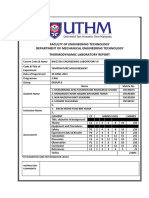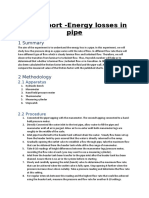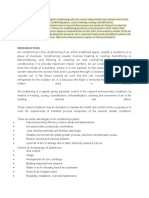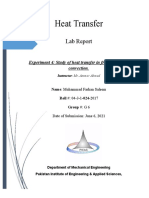Experiment 5
Uploaded by
FizaFiyExperiment 5
Uploaded by
FizaFiyERT 245- Heat and Mass Transfer in Biological Systems
Laboratory Module
EXPERIMENT 5
EVALUATE HEAT TRANSFER COEFFICIENT OF FREE & FORCE
CONCVECTION HEAT EXCHANGER
1.0 OBJECTIVES
1.1 To demonstrate the relationship between power input and surface
temperature in free and force convection.
1.2 To demonstrate the use of extended surface to improve heat transfer from the
surface.
2.0 INTRODUCTION
Heat transfer by simultaneous conduction and convection, whether free or force,
forms the basis of most industrial heat exchangers and related equipment. The
measurement and prediction of heat transfer coefficients for such circumstances is
achieved in the Free and Force Convection Heat Exchanger Apparatus by studying the
temperature profiles and heat flux in an air duct with associated flat and extended
transfer surfaces. The vertical duct is so constructed that the air temperature and
velocity can be readily measured, and a variety of plug-in modules of heated solid
surfaces of known dimensions can be presented to the air stream for detailed study. A
fan situated at the top of the duct provides the air stream for forced convection
experiments. Using the instrumentation provided, free and forced convective heat
transfer coefficients may be determined for: 1. A flat surface
2. An array of cylinders (pinned heat sink)
3. An array of fins (finned heat sink)
ERT 245- Heat and Mass Transfer in Biological Systems
Laboratory Module
3.0 THEORY
3.1 Free Convection
A heated surface dissipates heat primarily through a process called convection.
Heat is also dissipated by conduction and radiation, however these effects are not
considered in this experiment. Air in contact with the hot surface is heated by the
surface and rises due to a reduction in density. The heated air is replaced by cooler
air which is in turn heated by the surface and rises. This process is called free
convection. The hotter the temperature of the surface, the greater the convective
currents and more heat (power) will be dissipated. If more power is supplied to a
surface, the temperature of the surface must rise to dissipate this power.
3.2 Forced Convection
In free convection the heat transfer rate from the surface is limited by the small
movements of air generated by this heat. More heat is transferred if the air velocity is
increased over the heated surface. This process of assisting the movement of air over
the heated surface is called forced convection. Therefore a heated surface experiencing
force convection will have a lower surface temperature than that of the same surface in
free convection, for the same power input.
3.3 Extended Surface
Heat transfer from an object can be improved by increasing the surface area in
contact with the air. In practice it may be difficult to increase the size of the body to suit.
In these circumstances the surface area in contact with the air may be increased by
adding fins or pins normal to the surface. These features are called extended surfaces. A
typical example is the use of fins on the cylinder and head of an air cooled petrol engine.
The effect of extended surfaces can be demonstrated by comparing finned and pinned
surfaces with a flat plate under the same conditions of power input and airflow.
ERT 245- Heat and Mass Transfer in Biological Systems
Laboratory Module
4.0 MATERIALS AND EQUIPMENTS
4.1 DESCRIPTION OF APPARATUS
Figure 1: Free and Force Convection Heat Exchanger Apparatus.
1. Fan
3. RTD sensors
5. Panel
2. Air flow column
4. Portable Anemometer
6. Exchangeable Heat Transfer System
ERT 209- Heat and Mass Transfer
Laboratory Module
5.0 PROCEDURES
5.1
Experiment 1: To demonstrate the relationship between power
input and
surface temperature in free convection.
5.1.1
Place the flat finned heat exchanger in to the duct.
5.1.2
Record the ambient air temperature (tA),
5.1.3
Set the heater power control to 20 Watts. Allow sufficient time to achieve steady state
conditions before noting the heated plate temperature (tH).
5.1.4
Repeat the procedure at 40, 60 and 80 Watts.
5.2 Experiment 2 : To demonstrate the relationship between power input and
surface temperature in force convection (finned heat
exchanger)
5.2.1
Set the heater power control to 50 Watts. Allow sufficient time to achieve steady state
conditions before noting the heated plate temperature (tH).
5.2.2
Set the fan speed control to give a reading of 0.5m/s on the thermal anemometer.
Record the heated plate temperature (tH).
5.2.3
Repeat this procedure at 1.0m/s and 1.5m/s.
5.3 Experiment 3: To demonstrate the use of extended surface to improve heat
transfer from the surface.
5.3.1
Place the tube bundle plate heat exchanger into the duct.
5.3.2
Set the heater power control to 75 Watts. Allow the temperature to rise to 80C, and
then adjust the heater power control to 15 Watts until a steady reading is obtained.
Record heated plate temperature (tH).
5.3.3
Set the fan speed control to give 1m/s.
5.3.4
Repeat this procedure at 2.0 and 2.5m/s.
-4-
ERT 209- Heat and Mass Transfer
Laboratory Module
6.0 RESULTS AND CALCULATION
6.1 For experiment 1
Input Power
Watts
20
40
60
80
Plate Temp (tH)
C
Ambient Temp (tA)
C
tH tA
C
6.2 For experiment 2
Air Velocity
m/s
0
0.5
1.0
1.5
Plate Temp (tH)
C
Ambient Temp (tA)
C
tH tA
C
6.3 For experiment 3
Velocity
m/s
0
1
2
2.5
Plate Temp (tH)
C
Ambient Temp (tA)
C
tH - tA
C
6.4 For experiment 1, based on the data recorded, plot the graph of power against
temperature (tH tA).
6.5 For experiment 2 and 3, based on data recorded, plot the graph of air velocity against
temperature (tH tA).
7.0 DISCUSSION
7.1 Why is it necessary to set the fan speed to maximum before switch OFF the apparatus?
7.2 How do the extended surface for the plate heat exchanger will improve the heat transfer
process?
7.3 Differentiate between free and forced convection.
7.4 Discuss the relationship between air velocity and surface temperature.
7.5 Discuss the relationship between powers dissipated and surface temperature.
8.0 CONCLUSION
8.1 Based on the experimental procedure done and the results taken draw some conclusions
to this experiment.
-5-
You might also like
- Experiment #1: Fourier'S Law: Conduction Along A Simple Bar100% (2)Experiment #1: Fourier'S Law: Conduction Along A Simple Bar6 pages
- Experiment No. 4 Forced Convection Heat Transfer From A Flat Plate To Air 1No ratings yetExperiment No. 4 Forced Convection Heat Transfer From A Flat Plate To Air 13 pages
- MENG 412 Thermal Science Laboratory Expt. 6: Extended Surface Heat Transfer100% (1)MENG 412 Thermal Science Laboratory Expt. 6: Extended Surface Heat Transfer10 pages
- Laboratory Report 10 (Drag On A Sphere)No ratings yetLaboratory Report 10 (Drag On A Sphere)16 pages
- Experiment 5 - Calibration of Bourdon Tube Pressure Gauge100% (1)Experiment 5 - Calibration of Bourdon Tube Pressure Gauge6 pages
- Discussion and Conclusion For Marcet Boilers75% (4)Discussion and Conclusion For Marcet Boilers2 pages
- Free/Force Convection H.T From Pinned&finnedNo ratings yetFree/Force Convection H.T From Pinned&finned14 pages
- Experiment 4 (Combined Convectionn Radiation) PDF100% (2)Experiment 4 (Combined Convectionn Radiation) PDF8 pages
- 1-Thermal Conductivity of Liquids (Glycerol)No ratings yet1-Thermal Conductivity of Liquids (Glycerol)4 pages
- Combined Convection and Radiation Report - OdtNo ratings yetCombined Convection and Radiation Report - Odt9 pages
- Experiment No.5 Forced Convection: Heat Transfer Laboratory (MECH3123)No ratings yetExperiment No.5 Forced Convection: Heat Transfer Laboratory (MECH3123)6 pages
- Undamped Free Vibration-Lab Report: Author: Muhammad Sohaib AlamNo ratings yetUndamped Free Vibration-Lab Report: Author: Muhammad Sohaib Alam11 pages
- Lab Report - Energy Losses in Pipe: 1 SummaryNo ratings yetLab Report - Energy Losses in Pipe: 1 Summary10 pages
- Experiment 1.thermal Conductivity of Metal Rod-3No ratings yetExperiment 1.thermal Conductivity of Metal Rod-36 pages
- Experiment of Refrigeration and Air Conditioning100% (1)Experiment of Refrigeration and Air Conditioning30 pages
- 04 Exp # 4,5,6,7 Free & Forced ConvectionNo ratings yet04 Exp # 4,5,6,7 Free & Forced Convection13 pages
- Water Treatment System - Thermogenics Mexico OTSG PDFNo ratings yetWater Treatment System - Thermogenics Mexico OTSG PDF15 pages
- GDPR Consent Form Wroclaw Con Corde 2024No ratings yetGDPR Consent Form Wroclaw Con Corde 20242 pages
- It's All Coming Back To Me Now Free Sheet Music by Celine Dion - Pianoshelf PDFNo ratings yetIt's All Coming Back To Me Now Free Sheet Music by Celine Dion - Pianoshelf PDF2 pages
- Perencanaan Gudang Penyimpanan Bahan Kimia Pada Gd01 Perusahaan Manufaktur AlutsistaNo ratings yetPerencanaan Gudang Penyimpanan Bahan Kimia Pada Gd01 Perusahaan Manufaktur Alutsista6 pages
- Technical Specifications: Make: Typhoon Hil GMBH, Switzerland, Model: Hil 604No ratings yetTechnical Specifications: Make: Typhoon Hil GMBH, Switzerland, Model: Hil 6042 pages
- 8051 Interfacing: Interfacing To 8051 I/O PortsNo ratings yet8051 Interfacing: Interfacing To 8051 I/O Ports11 pages
- Surge Protection Devices A Risk Assessment ApproachNo ratings yetSurge Protection Devices A Risk Assessment Approach2 pages
- Universiti Tun Hussein Onn Malaysia: ConfidentialNo ratings yetUniversiti Tun Hussein Onn Malaysia: Confidential4 pages
- LPG Air Mix/Sng Plant Operations - Communique # 1 Functional Re-Organization at Head Office and Other Directives About State of Affairs at PlantsNo ratings yetLPG Air Mix/Sng Plant Operations - Communique # 1 Functional Re-Organization at Head Office and Other Directives About State of Affairs at Plants3 pages
- DEMKO 16 ATEX 1706U Rev 0 XCEX XCESX IIB H2 20 3591No ratings yetDEMKO 16 ATEX 1706U Rev 0 XCEX XCESX IIB H2 20 35913 pages
- Nonlinear Finite Element Analysis of Latticed Transmission TowersNo ratings yetNonlinear Finite Element Analysis of Latticed Transmission Towers11 pages
- Design of Machine Members Bits With AnswersNo ratings yetDesign of Machine Members Bits With Answers5 pages
- Experiment #1: Fourier'S Law: Conduction Along A Simple BarExperiment #1: Fourier'S Law: Conduction Along A Simple Bar
- Experiment No. 4 Forced Convection Heat Transfer From A Flat Plate To Air 1Experiment No. 4 Forced Convection Heat Transfer From A Flat Plate To Air 1
- MENG 412 Thermal Science Laboratory Expt. 6: Extended Surface Heat TransferMENG 412 Thermal Science Laboratory Expt. 6: Extended Surface Heat Transfer
- Experiment 5 - Calibration of Bourdon Tube Pressure GaugeExperiment 5 - Calibration of Bourdon Tube Pressure Gauge
- Experiment No.5 Forced Convection: Heat Transfer Laboratory (MECH3123)Experiment No.5 Forced Convection: Heat Transfer Laboratory (MECH3123)
- Undamped Free Vibration-Lab Report: Author: Muhammad Sohaib AlamUndamped Free Vibration-Lab Report: Author: Muhammad Sohaib Alam
- Water Treatment System - Thermogenics Mexico OTSG PDFWater Treatment System - Thermogenics Mexico OTSG PDF
- It's All Coming Back To Me Now Free Sheet Music by Celine Dion - Pianoshelf PDFIt's All Coming Back To Me Now Free Sheet Music by Celine Dion - Pianoshelf PDF
- Perencanaan Gudang Penyimpanan Bahan Kimia Pada Gd01 Perusahaan Manufaktur AlutsistaPerencanaan Gudang Penyimpanan Bahan Kimia Pada Gd01 Perusahaan Manufaktur Alutsista
- Technical Specifications: Make: Typhoon Hil GMBH, Switzerland, Model: Hil 604Technical Specifications: Make: Typhoon Hil GMBH, Switzerland, Model: Hil 604
- Surge Protection Devices A Risk Assessment ApproachSurge Protection Devices A Risk Assessment Approach
- LPG Air Mix/Sng Plant Operations - Communique # 1 Functional Re-Organization at Head Office and Other Directives About State of Affairs at PlantsLPG Air Mix/Sng Plant Operations - Communique # 1 Functional Re-Organization at Head Office and Other Directives About State of Affairs at Plants
- DEMKO 16 ATEX 1706U Rev 0 XCEX XCESX IIB H2 20 3591DEMKO 16 ATEX 1706U Rev 0 XCEX XCESX IIB H2 20 3591
- Nonlinear Finite Element Analysis of Latticed Transmission TowersNonlinear Finite Element Analysis of Latticed Transmission Towers

























































































